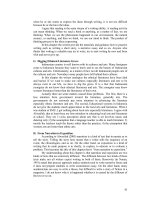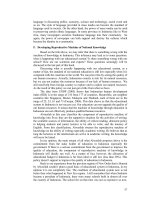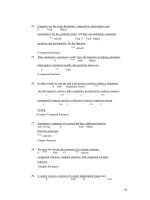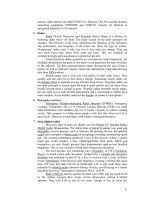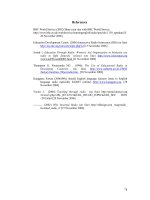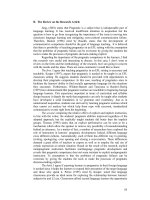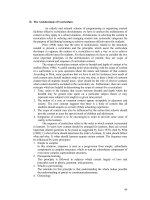Teaching and learning english part 8
Bạn đang xem bản rút gọn của tài liệu. Xem và tải ngay bản đầy đủ của tài liệu tại đây (407.34 KB, 7 trang )
50
Wikepidia. (2003 Plgiarism. ( [10 Desember
2006]
------------
( />
[10 Desember 2006]
51
A Critical Review of Alwasilah’s
“POKOKNYA SUNDA”
Muhammad Sukrianto
A. Introduction
“A Real Sundanese”, this term is an appropriate appreciation for Alwasilah
who has written this book. His brilliant ideas show how he concerns to think and to
care of Sundanese identities especially the culture. The ideas to preserve the culture
and to revitalize the identity of Sundanese show that Alwasilah loves his people
very much.
In this book “Pokoknya Sunda”, Alwasilah seems to motivate especially
Sundanese to be more aware of themselves, what they have, and how their
generation in the future. The idea to revitalize the identity of Sundanese means that
Sundanese have much strength in their identity of life. Alwasilah wants Sundanese
to realize their strength, what they have and how they preserve them.
Actually, this book is very interesting to read, not only for Sundanese but also
the people who are not Sundanese. From this book we can get many things that we
do not know or sometimes we do not realize. We sometimes do not realize that
many things happened and many things changed in our life. For instances, the
culture we have, the language we use, have changed without any attention from us.
These phenomena sometimes lead to change our identities.
As a Sundanese, Alwasilah realizes what has changed especially in the
identities of Sundanese. In this critical review the writer tries to analyze, to
comment and to criticize what Alwasilah writes in this book “Pokoknya Sunda.”
B. The Revitalization of Sundanese Identity
The first part of this book discusses the ideas of how to revitalize the identity
of Sundanese; their culture, language and character. Based on the phenomena
happened in the community of Sunda, Alwasilah finds many things have changed in
the identity of Sundanese. Some of them are the culture and the reluctant of some
Sundanese to speak Sunda language. Concerning with this problem, I would like to
discuss and to review some aspects of
the identity of Sundanese. Some Sundanese,
slow but sure are leaving their identity. They sometimes reluctant to speak
Sundanese, they do not know much about their culture, and they do not care to
preserve their culture.
Actually there are some matters caused these problems. The
first, Sunda is
one of the ethnics In Indonesia. It means that Sunda is not different from other
ethnics in Indonesia. Indonesia consists of many ethnics with their different culture
and languages that unite into one nation, Indonesia. Hence the national vision will
impinge with the ethnic one.
Second, Sundaneses live near the capital city of
Indonesia where many people who are not Sundanese live there. The complexity of
community may influent how Sundanese behave.
Next, Some Sundanese supposes
that they are modern people. Their misinterpretation is that modern means following
western country. Hence they won’t speak Sundanese but speak Indonesia or English.
Furthermore, I have a contra opinion to what Alwasilah said that Sundanese
especially youngsters may leave
Undak Usuk of Sundanese since it is one of the
problems that make them reluctant to speak Sunda. I don’t agree with this statement.
The youngsters have to learn
undak usuk of Sundanese since it is the identity of
52
Sundanese. In my opinion, undak usuk basa still need to be applied whatever it is.
Undak usuk basa or what we call speech level can make language sounds modesty
and it plays a role as controller of person’s attitude and behavior. Haerudin (2006)
states, “kesulitan masyarakat menggunakan bahasa Sunda dalam kehidupan
kesehariannya, bukan karena ada dan tiadanya UUBS, tetapi alasan kebutuhan
(keperluan) berbahasanya.” It means that the most important thing is how to make
Sundanese think that they need to speak or to use Sunda Language.
There are some efforts have been done to revitalize Sundanese cultures. As
what Alwasilah proposes that there are three steps to revitalize Sundanese cultures:
(1) understanding to evoke the awareness, (2) planning collectively, (3) evocation of
culture creativity. Based on my opinion these efforts are not an easy thing to do.
Suyanto (2006) says, “Merevitalisasi budaya lokal tidak lagi mudah dilakukan
secara tiba-tiba. We can do the evocation of cultural creativity if we plan it
collectively, but we can not make such a planning without any understanding and
the awareness. The most difficult effort to do is to unite the understanding so that it
will arouse the awareness of Sundanese in one vision to revitalize their identity. The
collective planning to make cultural strategy will never come up without having the
same vision (the same understanding and awareness) completely.
Discussing Sunda in world forum through KIBS (International conference of
Sundanese culture) is one of the ways to apply the efforts as what Alwasilah
proposes above. Again it is just one of the ways. There is no guaranty that it will be
success to build Sundaneses understanding and awareness toward the revitalization.
At least, it is a good step to do.
Introducing Sundanese culture to an international forum is not a bad thing to
do but the most important thing is KIBS have to find the applicable strategies how
to introduce Sundanese culture to the Sundanese especially youngsters. Sundanese
youngsters should be the object of cultural diplomacy. It is in line with what
Alwasilah says, “
Bila orang asing mampu menghargai karya sastra Sunda,
mengapa kaum intelektual Sunda bersikap hare-hare.”
It means that the cultural
diplomacy is not exactly for the international community, but for the Sundaneses
them selves. How can ordinary people appreciate the culture while the intellectual
Sundaneses acted
hare-hare?
Furthermore, Alwasilah proposes the renaissance of Sunda. This idea at a
glance seems too extreme since it shows that the revitalization of Sunda is in the
emergency level. It means that without any serious attention from all Sundaneses
especially the intellectuals, the culture or even the identity of Sundaneses may lose.
Hawe Setiawan, one of Sundanese intellectual is still hesitated toward this great idea
since it is like a lighthouse without any real action to do. In this case, Setiawan may
not be completely wrong. The seven arguments proposed by Alwasilah in
responding to what Setiawan hesitated are theoretically true. It is undeniable,
however, that in implementing the seven arguments is not an easy thing to do. For
example is the idea to make Sundanese become erudite languages. Since we still
have Indonesia, a nasional language, this idea is not an easy thing to do. There could
be many Sundanese intellectuals who are able to write in Sundanese, but not all of
them want to. They think writing a book in Indonesia is better.
The idea to form the Sunda study centre is a very beneficial media to discuss
the strategies and techniques to revitalize Sundanese culture. But again as what
Alwasilah said, it needs a consensus or at least an understanding among Sundanese
53
intellectuals. This institute should be perceived to reach the vision and the goals
collectively.
In running the programs of the Sunda study centre, it is not as easy as to say.
It needs not only many brilliant ideas or many of human resources but also money.
In this case LPSS (the institute of Sunda study centre) have to entangle the
entrepreneurs or conglomerates. Actually this issue is not discussed by Alwasilah.
The support from Sundanese conglomerate sponsors is very needed to support the
program of LPSS. If all components of Sundanese, the government (bureaucratic
elements), intellectuals, and conglomerates support the programs of LPSS
simultaneusly, we are at all convinced that the revitalization of Sundanese cultures
and identities will be succeeded.
C. Correcting Mother Tongue Politic
Mother tongue is the language acquired by someone for the first time. It has a
great influence to how someone thinks and behaves. Since 1951 UNESCO
recommended mother tongue as a medium of instructional in education (Alwasilah,
2006:57). Alwasilah sees that mother tongue should be empowered to support
someone in acquiring the knowledge and sciences. Concerning with the
maintaining of a mother tongue, Alwasilah proposes five reasons: 1) realizing the
cultural diversities, 2) preserving the ethnical identities, 3) enabling social
adaptability, 4) psychologically adding children security, and 5) improving
sensitivity of linguistics.
Actually, there is no doubt about the importance of a mother tongue for
someone life. But sometimes the problem is like what Indonesian proverb says,
“Beans forget at its husk.” Some people especially the youngsters don’t want to
speak in their mother tongue. There is a sense that speaking by using mother tongue
is countrified. Dedi Gumelar, an actor and cultural observer, hesitated at Sundanese
loyalty to speak in Sunda especially the youngsters (Kompas, April 13
th
2005).
Many Sundanese youngsters are reluctant to speak Sundanese. They often use
Indonesia with Betawi styles such as “lo and gua” in saying “you and I.” In their
mind Sunda is not popular and not so special.
Furthermore, the hesitancy is also stated by Taufikurraman (Kompas, 13 April
2005). Taufikurrahman is a chairman of Sunda art and language institute. He said
that he doesn’t listen to Dada Rosada, the lord mayor of Bandung, speaking Sunda
language yet. As a public fugure of Sundanese, the lord mayor of Bandung should
be a volunteer in campaigning Sunda Language.
Based on phenomena above, the vitality of a mother tongue is facing many
barriers. The vitality means that mother tongue is used in daily communication,
interaction in community and instructional language. What Alwasilah said, that the
students at primary school are easy to understand the lessons by using mother
tongue could be right. The students may understand the lessons faster than if it is
transferred by using the second language. But, it also may generate a new problem.
The students may be late to acquire Indonesia as national language. Since most of
schoolbooks are printed in Indonesia language, the students will face difficulty to
understanding the lesson because they can not understand Indonesia.
Actually, since we have Indonesia as national language and its function as a
medium of unifier, we may not widely functioned mother tongue because Indonesia
is more powered than mother tongue. If we push mother tongue to function more
than Indonesia, I think this effort is not popular. Mother tongue (ethnic language) is
54
different from Indonesia language. Historically Indonesia language was formed
from many mother tongues from all over ethnic in Indonesia. In this case mother
tongues enrich Indonesia language.
Alwasilah’s idea that mother tongue especially Sunda should be revitalized is
a fair matter. What I don’t agree is when the writer equalized Sunda with the Dutch
language. Although the speakers of Sunda are much more than the Dutch, but the
level of languages are different. The Dutch is a national language, but Sunda is just
an ethnic language in Indonesia. In other word we can say that a mother tongue
should have vitality in its speaker or in the area where the ethnic lives, because the
revitalization of a language should be under its low and destiny.
The number of the origins who speak Sunda based on the data given by
Alwasilah is more than 20 million. This number is more or less the same with the
number of Malaysia or Australia population. Alwasilah believes that the number of
speakers show the vitality of Sunda language. Actually I have a contrary opinion
about this. Although the number of speakers is much more adequate, but it is not a
guaranty that Sunda is save from destruction. The main problem is that the location
of Sundanese is near the capital city of Jakarta. This condition make Sunda face
different challenging to preserve comparing with other mother tongue in Indonesia.
The influence of Indonesian Language to Sundaneses seems stronger than to other
ethnic in Indonesia.
Discussing the seven strategies to prevent the destruction of Sunda is also
interesting. Ideally if the strategies could be implemented collectively, Sunda
language would never totally disappear. The problem is that not all Sundaneses have
the same perception about this problem. I believe that Java language has more
vitality than Sunda. Sundaneses view about their mother tongue is different from
Javanese. Culturally, Javanese are loyal to speak using their mother tongue. There is
an example that in Suriname where the origins were from Java, but still they speak
Java until now. It means that the vitality of a mother tongue does not only depend on
the number of the speakers but also on the perception of the speaker toward the
language.
D. Writing Activity in Civil Society
One of the characteristics of civil society is when the civilians are developed
with the culture of reading and writing. The writing activity plays an important role
to develop the quality of society. It can be the indicator of an educated people. It
means that the tradition of educated people is to communicate and to interact by
using the media of writing. The activity of reading and writing becomes a culture in
their life. The civilians promote their life style through the quantity and quality of
reading and writing. The fact shows that when someone is writing means he has
read first.
In Indonesia the ability writing are not developed well. As a matter of fact,
the writing activities at school are not fully appreciated. The students or even the
teachers are reluctant to write. For most of people in Indonesia, writing is not an
easy thing to do. When it is compared with the culture of western countries, the
quantity and the quality of Indonesian in writing is still left behind.
Apart from what has been happened, Alwasilah claims that New Order
Regime plays an important role in causing to this phenomenon. I do not think that
what Alwasilah claims is completely true. The lack ability of Indonesian in writing

